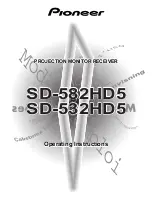
61
Appendices
Glossary
Following is an explanation of some of the terms used in this guide which may be unfamiliar or which were
not explained in the manual itself. Further information can be obtained by referring to other commercially-
available publications.
3-2 pull-down
detection-type IP
conversion
This function directly converts image sources that have been recorded in the same 24-frame
format used for movies into 60-frame progressive signals. This allows data such as DVD
software that has been recorded in 24-frame format to be played back on large screens with
more natural and accurate reproduction, without any loss of image quality from the original
movie.
Aspect ratio
The ratio between an image's length and its height. HDTV images have an aspect ratio of 16:9
and appear elongated. The aspect ratio for standard images is 4:3.
Color
difference
signal
(component)
A type of video signal output by video equipment which actually consists of three separate
signals: a red + luminance signal (R-Y), a luminance signal (Y) and a blue + luminance signal
(B-Y). Each signal is transmitted along a separate cable. Color difference signals generally
result in a better image than composite signals (in which the red, green and blue signals and
the luminance signal are all transmitted along a single cable).
Color
temperature
The temperature of an object which is emitting light. If the color temperature is high, the
colors tend to take on a bluish tinge. If the color temperature is lower, the colors tend to take
on a reddish tinge.
Component video
Video signals which have the video brightness signals and color signals separated, in order to
provide better image quality.
In high-definition TV (HDTV), it refers to images which consist of three independent signals:
Y (luminance signal), and P
B
and P
R
(color difference signals).
Composite video
Video signals which have the video brightness signals and color signals mixed together. The
type of signals commonly used by household video equipment (NTSC format).
The signals consist of the carrier signal Y (luminance signal) and the chroma (color) signal
which are contained in the color signal.
Contrast
The relative brightness of the light and dark areas of an image can be increased or decreased
in order to make text and graphics stand out more clearly, or to make them appear softer.
Cool-down
The cooling process for the projector lamp continues even after the [STANDBY/ON] button
on either the remote control or the projector's control panel has been pressed to turn off the
projector. All button operations for the emote control and the projector's control panel are
disabled while the cooling fan is operating at this time. The length of time that this is
happening is called the "cool-down period". The cool-down period lasts for about 5 minutes.
The actual time will vary depending on the external air temperature.
DCDi function
An abbreviation for Directional Correlational Deinterlacing. Refers to a high-resolution
image circuit function developed by Faroudja. It incorporates the latest in edge cutting
technology to smooth the jaggedness from the edges of images that have been converted from
interlaced to progressive video, in order to provide more natural images.
DVI
Abbreviation for Digital Visual Interface. Refers to a standard method for digital
transmission of video signals.
DVI is a standard that is also targeted towards digital household appliances other than
computers.
Film judgment
function
This function determines whether or not the video source is a 24 Hz progressive film source.
Gain
The adjustment of minute changes in color that occur as result of factors such as differences
in the equipment used to display images. It adjusts the coloration in brighter ranges separately
for R, G and B components.
Gamma
The adjustment of minute changes in color that occur as result of factors such as differences
in the equipment used to display images. It adjusts the coloration in intermediate ranges
separately for R, G and B components.
HDTV
An abbreviation for High-Definition Television. It refers to high-definition systems which
satisfy the following conditions.
••••
It may also include vertical resolutions of 720p or 1080i or above (p = progressive
scanning; i = interlaced scanning) or 480p.
••••
Screen aspect ratio of 16:9
••••
Dolby Digital audio reception and playback (or output)
Содержание LPX-500
Страница 1: ...OWNER S MANUAL LPX 500 Home Cinema Projector an English 403256900 U C A G B R T ...
Страница 8: ...3 Accessories Check the included accessories Remote control Setup guide Battery LR6 AA x 2 Power cord ...
Страница 59: ...56 Appearance 281 11 06 125 4 92 409 16 1 111 4 37 Units mm inch ...
















































